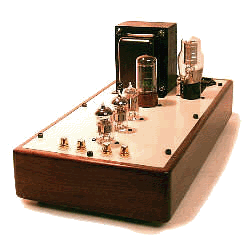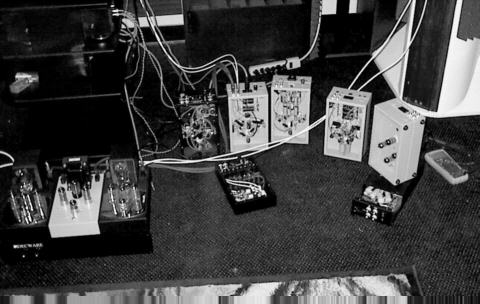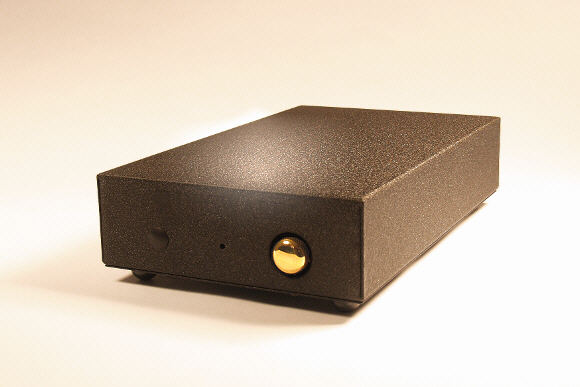|
INTRODUCTION The ZP3 phono stage has been in development for several years as a one-box alternative to our ZP1.0 phono stage that used a remote power supply. The ZP1.0 was designed as a reference grade phono stage. To reach the performance level it did, it required it's own dual mono remote power supply which priced it out of reach for many people. You can read about the work that went into it in the following two papers, Diary of a Phono Stage" and Official White Paper for the ZP1.0
In fact as I recall it wasn't all that easy even with a remote power supply. When you build something as sensitive as a phono stage, your dealing with around 40 dB of gain or more so a lot of the design process is focused on the absence of noise and or hum. Part of the thing that made it difficult in the first place was the point-to-point wiring vs. using a circuit board. During that crazy design fest (above) that brought about the ZP1.0, one of my favorite sounding of the 5 best prototypes was actually the split passive RIAA I had loosely based on a 2003 circuit by J. Epstein. Due in part to my layout and point-to-point construction I had small noise/hum issues with most of the prototypes including that one. For that reason, the nice quiet active circuit is what went into production and became our ZP1.0. In the years that followed and in response to requests for a less expensive tube phono stage, I tried repeatedly to re-make one of my old prototypes in a single chassis that was noise and hum free. If it could be done it would drop the price significantly over a two chassis design. My results always came close but I never as good as our ZP1.0. It became obvious after awhile that chassis design and layout were going to become the determining factors for success and they in fact were. Once we switched the bulk of our amplifier line over to the anniversary platform things began to fall together rather nicely. The non-magnetic chassis created an eddy-free environment that was far less prone to hum.
THE CIRCUIT The circuit is a split passive design with no negative feedback. It uses a tube rectified and tube regulated power supply with a DC heater supply. Execution of this circuit is unique in that the B+ voltages used to drive the circuit are far lower than normal. Similar circuits are using 330 volts to gain the maximum performance from the 12AX7 dual triodes. The ZP3 is using a B+ of 244 volts to gain maximum liquidity and lengthen tube life. Rather unconcerned about mathematical models and how good the circuit looks on paper, the complete emphasis here is was on sound quality. Lowering the voltage set the stage for several wonderful things to happen. Things like greater sound stage depth, a more natural and realistic image, a more organic timbre, less artificial spotlighting of certain instruments and just a sense of ease. The reason we listen to vinyl in the first place is because it doesn't sound like CD's. I didn't want a phono stage that sounds like a really good DAC but rather one that clearly makes a really good DAC sound bad. The biggest question I'll be asked regarding the ZP3 is how can it possibly be as good or better than the remote powered dual mono ZP1.0? The answer is that the ZP3 power supply is 150ma with only a 30 ma current draw from the circuit. That's about three times the size of the ZP1.0's dual mono supply. The ZP3 also uses tube rectification while the ZP1.0's was solid state rectified. Then the ZP3 takes it one giant step beyond with tube voltage regulation. It is a serious overkill power supply for a phono stage. It also uses a passive RIAA rather than active and that eliminates having to use negative feedback. This gives it better dynamics, better midrange presence, slightly more detail and better depth.
Keeping the high current and heat generating parts off the circuit board ensures the high quality board will never fail or develop noise with age because it will never heat up. Even the dual triode sockets are chassis mounted (vs. mounted on the board) in such a way as to make it impossible to put any pressure on the circuit board during tube replacement. The board actually floats on the back of the ceramic tube sockets isolating it from heat and vibration. The T6 aluminum chassis, combined with a white powder coat finish, blocks heat and keeps the tubes from punishing the circuit board. The rectifier tube being the largest source of heat is isolated in the point-to-point wired power supply section of the chassis. By keeping the interconnects from the optional rear jacks completely off the board and keeping signal traces for the audio circuit incredibly short we preserve fidelity. Long circuit board traces in the signal path will not have the fidelity of good silver wire in Teflon insulation. Another feature of this design approach is the ground buss. As a designer I've learned that the ground buss is perhaps the largest single impact on the overall signal path besides components. A solid copper rod is hard to beat. That makes the ground plane covering the back side of the board in our ZP3 independent of the ground buss rather than becoming the ground buss as is typical to do. The overall ground scheme is now optimised with no current flowing through the chassis and the board becoming it's own sub network located at the end. Ground points are situated on the buss like dots on a line and ordered least to most according to current flow.
Internal parts ie., resistors and capacitors used throughout the ZP3 are audiophile components with 1% resistors and excellent sounding poly caps. Selling our products on a 30 day money back trial means putting your best foot forward so internal components and tubes are the highest of quality and carefully tested. Customization of the sound is rather effortless, you have 4 tubes you can roll, 5 if you start trying different voltage regulator tubes. To handle Moving Coil cartridges, the same super hi quality Sowter of England transformers that we used in the ZP1.0 series are being used as the step up device. The advantages of using step up transformers vs. just more gain are many. The blacker backgrounds and shimmer on the top end are in and of themselves justification for the greater expense and that's only two.
The adjustable cartridge damping that was on the ZP2.0 is being employed along with the Sowter transformers in a stand alone chassis and sold as a separate product. This is because there are many different Moving Coil cartridges with different specs. Most of them fall into 3 categories, of which there are transformers designed for each. There will be 3 models of the stand-alone step up transformer called ZMC1, ZMC2, ZMC3. Each for a different category of moving coil cartridge. All three will look identical and be the same price making it easy for customers to trade-in one for the other and so on.
Thanks go out to J. Epstein who's original circuit inspired my early prototypes, and to J. Haggerman who was kind enough to offer his Cornet circuit boards at one point along the way and let us modify them for use in a ZP3. Even though that didn't end up happening, it was much appreciated. (While the sound and implementation of these three circuits is very different, the Epstein, ZP3 and Cornet are using almost the same split passive RIAA scheme). . As a final note I would like to suggest that many people who've never gotten into vinyl can blame it directly on their phono stage / preamp. I've heard enough phono stages that sounded no better than a really good DAC to understand why so many people aren't turned on to vinyl. I've seen cartridges and tone arms rotated until I was dizzy when some of the worst performers turned out to be the best after the right phono stage was employed. It really won't matter how much you spend on a table, tone arm and cartridge if it can't breath through a wonderful sounding phono stage. And a great phono stage can easily sound better mated with a 300.00 cartridge than an average phono stage will with a 3000.00 cartridge. I wouldn't spend over $2500 on a phono stage without hearing a ZP3 side by side with it first.
Steve Deckert
|
|
Decware is a trademark of High Fidelity Engineering
Co.
|
 Since
then the ZP3
has been one of those pet projects of mine that I would
get out about every 6 months and try to make happen. I say
try, because I had set the a fairly high benchmark with our
ZP1.0 and didn't want to settle for anything less, especially in
the noise department. (That's where it always got sticky). It's
hard to build a phono stage in a single chassis that is as quiet
and one done with a remote power supply.
Since
then the ZP3
has been one of those pet projects of mine that I would
get out about every 6 months and try to make happen. I say
try, because I had set the a fairly high benchmark with our
ZP1.0 and didn't want to settle for anything less, especially in
the noise department. (That's where it always got sticky). It's
hard to build a phono stage in a single chassis that is as quiet
and one done with a remote power supply.
 To
ensure consistency in the noise spec for the ZP3, a circuit board
was developed for the RIAA section of the circuit leaving the rest
of it point-to-point like all of our other products. This proved
in the end to be the best of both techniques.
To
ensure consistency in the noise spec for the ZP3, a circuit board
was developed for the RIAA section of the circuit leaving the rest
of it point-to-point like all of our other products. This proved
in the end to be the best of both techniques.  The
front jacks that are standard on the ZP3 are located directly at
the front of the board and connected to it with 1 inch of flexible
silver/Teflon wire. This keeps the signal path leading into the
first input tube below 2 inches while maintaining total isolation
from the board. This way the jacks can never transfer any stress
to the board and slowly crack solder joints.
The
front jacks that are standard on the ZP3 are located directly at
the front of the board and connected to it with 1 inch of flexible
silver/Teflon wire. This keeps the signal path leading into the
first input tube below 2 inches while maintaining total isolation
from the board. This way the jacks can never transfer any stress
to the board and slowly crack solder joints.
